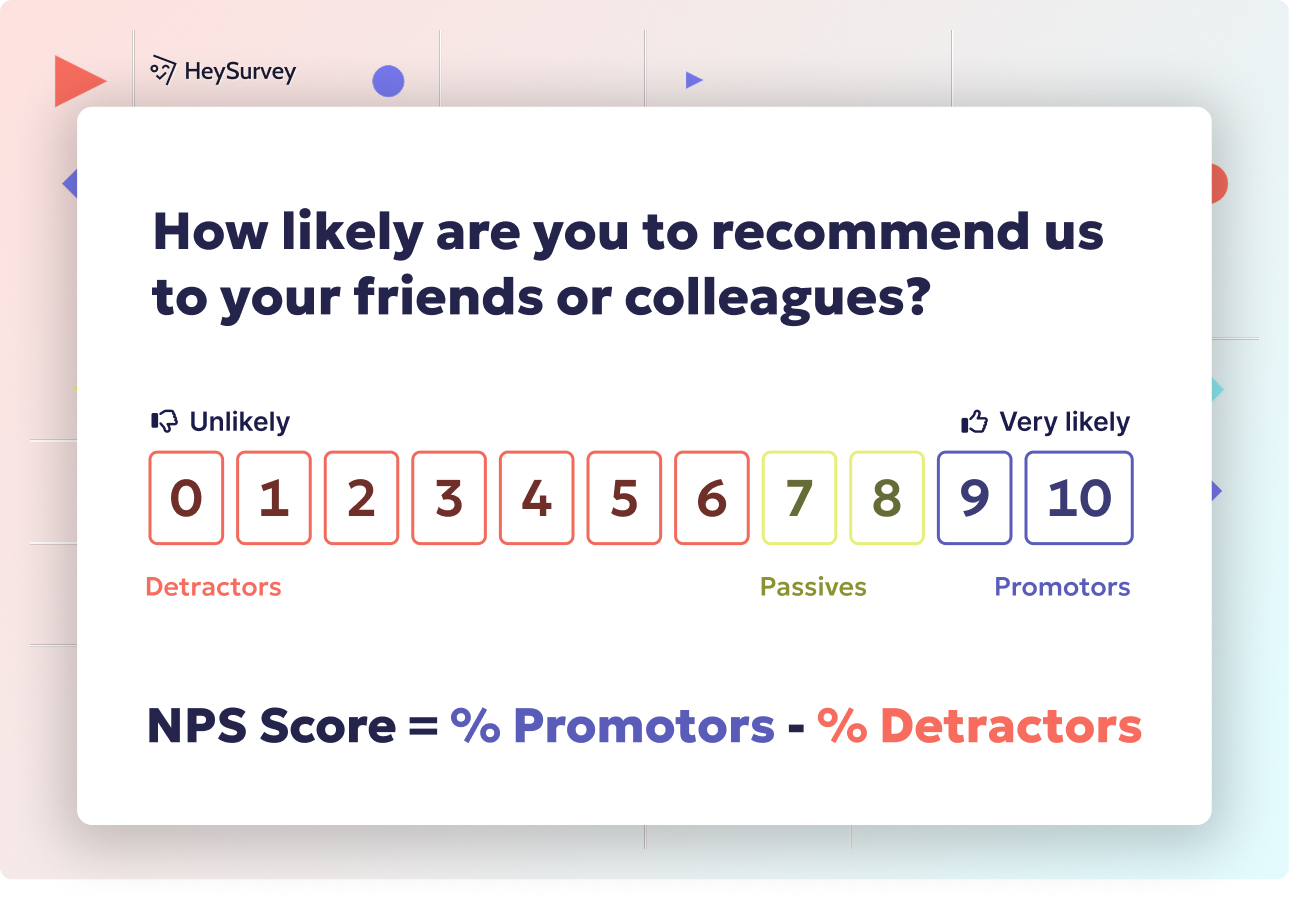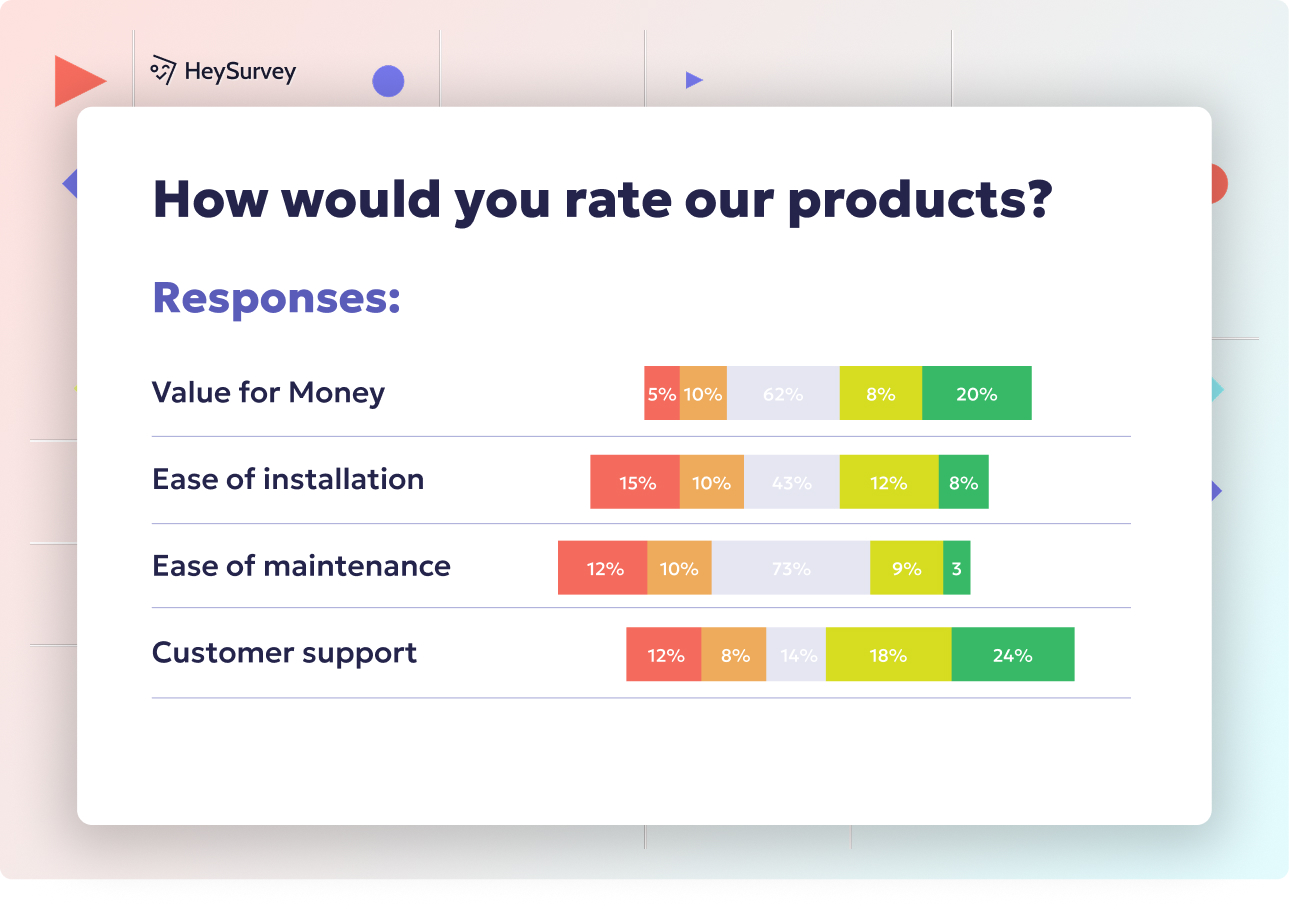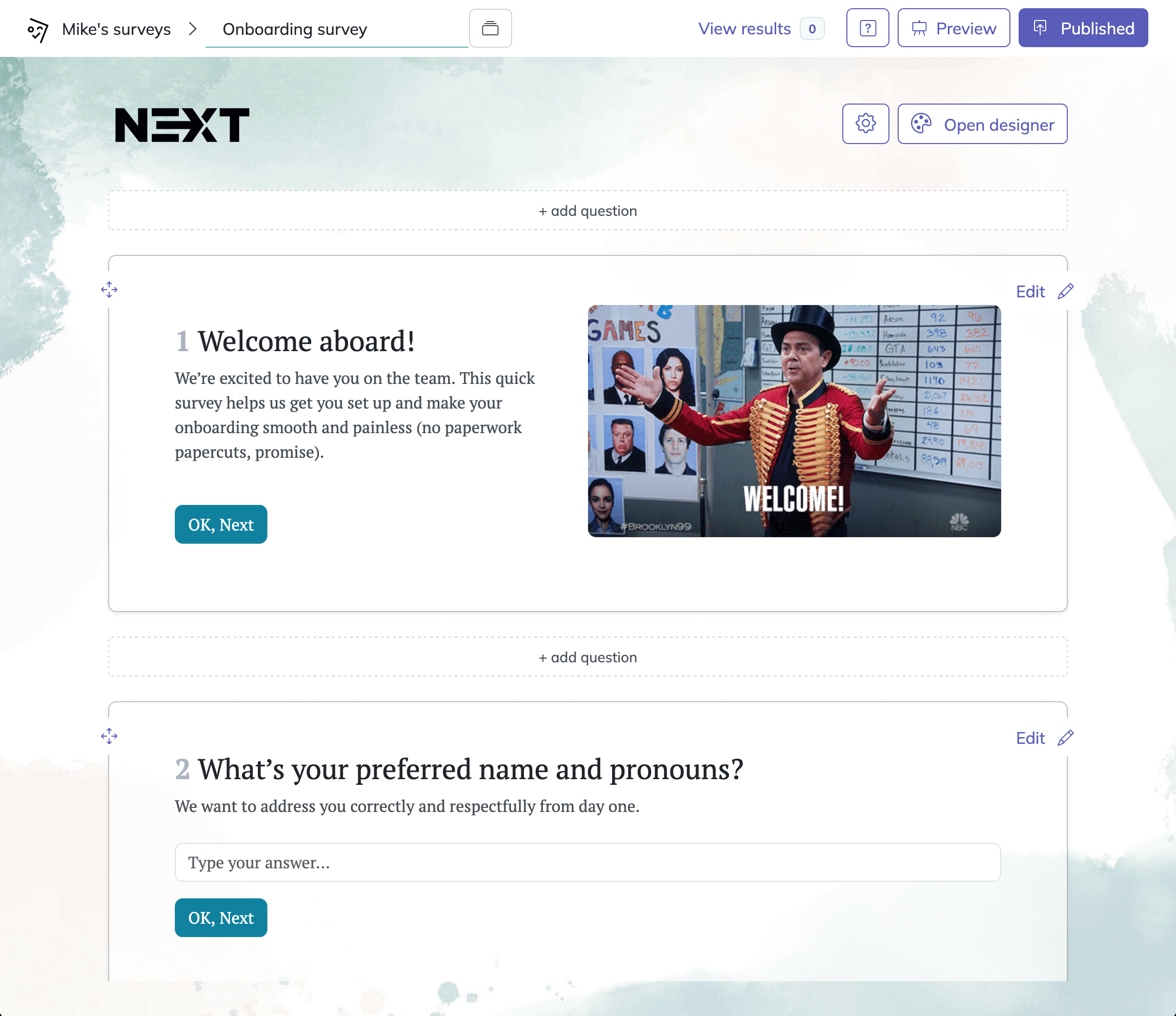31 Engagement Survey Questions for Work to Boost Productivity
Discover 30+ engagement survey questions for work to measure employee satisfaction, leadership, growth, and workplace culture effectively.
Employee engagement is the heartbeat of a thriving workplace. When companies take the pulse of their people with smart, engaging survey questions, they get more than just numbers—they uncover the real stories behind productivity, retention, and workplace culture. Well-written employee feedback surveys reveal what energizes your team, what weighs them down, and what keeps them around. Finding the right rhythm is key: some teams benefit from frequent “pulse” check-ins, while others lean into an annual routine. Wherever your team lands, tailored survey questions support every step of the employee journey, helping you measure employee engagement and improve workplace culture, one insight at a time.
Job Satisfaction Surveys
Why and When to Use This Survey Type
Job satisfaction surveys are like a company’s regular check-up—they help leaders spot early warning signs and celebrate what’s working well. They’re designed to measure employee job satisfaction and reveal how happy team members are with their day-to-day experiences. Knowing exactly when to roll out these surveys makes a critical difference.
Use them quarterly to benchmark happiness and spot any downward trends before they turn into bigger issues.
They’re especially valuable after major changes—think new leadership, a big project launch, or company restructuring.
The goal is to listen and learn: what’s making your employees smile, and what’s making them sigh? When you regularly collect this feedback, you give every team member a stake in improving workplace happiness. The magic lies in transforming those little friction points into opportunities for delight. For managers, these surveys also become a compass in navigating the waters of company culture, morale, and employee motivation.
Measuring workplace happiness isn’t about ticking boxes; it’s about understanding the moments—big and small—that define an employee’s experience. Use these surveys to draw out stories, suggestions, and solutions that make the workplace a little brighter for everyone.
Sample Questions
How satisfied are you with your current role and responsibilities?
Do you have the resources needed to do your job well?
How clear are your job expectations?
On a scale of 1–10, how likely are you to recommend this company as a great place to work?
What is one thing that would immediately improve your job satisfaction?
A study found that all four fairness dimensions—distributive, procedural, interpersonal, and informational—significantly affect overall job satisfaction among software practitioners, with interpersonal fairness having the greatest impact. (arxiv.org)

Creating an engagement survey with HeySurvey is as easy as pie—even if you’re totally new to the tool. Follow these three simple steps to get your survey up and running, plus a couple of bonus tips to make it look and work just right.
Step 1: Create a New Survey
- Head over to HeySurvey and choose to create a new survey. You can start from scratch with a blank sheet or save time by selecting a pre-built template designed for engagement surveys.
- Give your survey an internal name so you can easily find it later.
- Voilà! Your new survey workspace is ready for your magic touch.
Step 2: Add Questions
- Click Add Question to start building your list. HeySurvey offers tons of question types—from simple multiple choice to star ratings and open-ended text answers.
- Type in your carefully crafted engagement questions—whether you’re measuring job satisfaction, leadership feedback, or remote work experiences.
- Don’t forget to mark important questions as required if you want to make sure they get answered.
- You can also spice things up by adding images, descriptions, or even branching logic to personalize the survey path based on responses.
Step 3: Publish Your Survey
- Once your questions are in place, hit the Preview button to see how it looks and feels on desktop and mobile.
- Satisfied with the flow and design? Click Publish to make your survey live. HeySurvey will generate a shareable link you can send out to your team.
- Keep in mind that publishing requires setting up an account, but hey—it’s quick and free!
Bonus Step 1: Apply Your Branding
- Want your survey to scream your company’s personality? Upload your logo and customize colors, fonts, and backgrounds in the Designer Sidebar for that signature look.
- This helps boost recognition and makes filling out the survey feel more familiar and friendly.
Bonus Step 2: Define Survey Settings
- Get into the Settings Panel to fine-tune when your survey opens and closes by setting start/end dates.
- Limit the number of responses if you want to keep it exclusive, or add a redirect URL to thank participants with a custom webpage.
- You can also decide if respondents get to view results immediately or stay in suspense.
Bonus Step 3: Use Branching to Tailor the Experience
- Want to make your survey smarter? Use branching logic so that respondents only see questions relevant to their previous answers.
- This keeps surveys tight, relevant, and respectful of your team’s time—because no one likes unnecessary questions!
When you’re done building, you can effortlessly track results within HeySurvey or export them for deeper analysis. Start now by opening a ready-made engagement survey template below, and watch your employee insights soar!
Leadership & Management Feedback Surveys
Why and When to Use This Survey Type
Leadership engagement surveys are a bit like holding up a mirror—inviting honest feedback about what’s working and what’s not at the top. These surveys help leadership understand if their messages are hitting home and if their actions support employee engagement. Such surveys work wonders after transitions in management or organizational shake-ups.
Pinpoint strengths in leadership style, identify communication gaps, and shine light on areas where support falls short.
Use them post-restructuring to gauge how employees feel about recent changes, or regularly to keep a finger on the leadership pulse.
Employees who feel heard and supported by leadership are more likely to bring their best selves to work. A great manager feedback survey provides a safe way for staff to voice concerns about transparency, communication, and decision-making. These surveys not only drive accountability but also boost trust and morale.
Remember, these surveys aren’t just a suggestion box for complaints. The goal is to highlight both leadership wins and “areas for growth.” When employees see their feedback in action, it builds credibility at every level of the organization.
Sample Questions
My manager communicates expectations clearly.
Leadership demonstrates genuine interest in employee wellbeing.
I trust senior leaders to make the right decisions.
How often does your manager provide constructive feedback?
What can leadership do to better support you?
Employees who feel their voices are heard are 4.6 times more likely to perform their best work. (effectory.com)
Career Development & Growth Surveys
Why and When to Use This Survey Type
Career development feedback surveys are like rocket fuel for ambitious teams. They let you tap into employee dreams and ambitions while uncovering bottlenecks to professional growth. This survey shines brightest during performance review cycles or as a checkpoint before and after key trainings.
Measure if team members see a clear path to grow within your company.
Assess how well you’re delivering training, mentorship, and learning opportunities.
When employees feel like they’re moving forward, they’ll stay motivated—and stay with your company longer. Having a clear framework for advancement shows that you’re invested in their future, not just their output. And when you ask the right questions, you get the perfect blueprint for building tailored professional development programs.
Employee growth surveys don’t just look at skills—they explore praise, support, and long-term possibilities. They show staff that you’re listening and willing to invest in building capabilities. This feedback can fuel everything from leadership pipelines to cross-training initiatives and beyond.
Sample Questions
I see a clear path for advancement within this company.
I receive the training I need to grow professionally.
How satisfied are you with mentorship opportunities?
What additional skills would you like to develop this year?
Rate the effectiveness of current learning resources.
Recognition & Rewards Surveys
Why and When to Use This Survey Type
Recognition and rewards engagement drives are like confetti cannons for employee motivation. These surveys help you understand whether your team feels noticed, valued, and rewarded for their talents and hard work. Launch them after introducing a new rewards system or recognizing outstanding performance.
Run these surveys after implementing new recognition programs to gauge early impressions and tweak what isn’t landing.
They shine after compensation or benefits reviews, ensuring employees feel the love—not just the pay.
Employees who feel appreciated are more likely to go above and beyond. The sweet spot for these surveys is asking how meaningful, frequent, and fair recognition feels from both peers and manager alike.
Employee recognition survey questions should not only focus on formal bonuses but also on peer appreciation, shout-outs, and informal kudos. These micro-moments of gratitude build a culture where everyone is motivated to excel, celebrate one another, and stay engaged for the long run.
Sample Questions
I receive recognition for a job well done.
Rewards here reflect the effort I put in.
How meaningful are the recognition programs to you?
How frequently do you feel appreciated by colleagues?
Describe one way we could improve our rewards system.
Employees who receive recognition at least monthly are twice as likely to feel connected to their coworkers, experience a culture of trust, and have a strong sense of belonging within their organization. (achievers.com)
Work-Life Balance & Well-being Surveys
Why and When to Use This Survey Type
Work-life balance survey questions are the secret ingredient in any recipe for long-term employee happiness. With the line between work and home fuzzier than ever, surveying stress, workload, and well-being is non-negotiable. These surveys are perfectly timed after new wellness programs or policy changes like flexible hours.
Use them during the busiest periods—think end-of-quarter crunch or after a major project rush—to catch burnout before it flares up.
Gauge how well employees can disconnect and recharge on personal time.
Checking in on employee wellbeing shows you care about people, not just productivity. When you regularly measure the pulse on workload and work-life harmony, you get clued in to what needs tweaking for better balance. These surveys may trigger more flexible policies, improved time-off practices, or new wellness initiatives.
Employee wellbeing questionnaires also encourage open dialogue on topics like mental health, workload fairness, and support systems. Results spark candid conversations and tangible improvements, so everyone walks away a little lighter and a lot more motivated.
Sample Questions
My workload is manageable within my scheduled hours.
I can disconnect from work during personal time.
The company supports my mental health.
How often do you work overtime?
What would improve your work-life balance?
Diversity, Equity & Inclusion Engagement Surveys
Why and When to Use This Survey Type
DEI survey questions open the door to important conversations about belonging, representation, and fairness in the workplace. Companies often deploy these after launching diversity initiatives or to assess annual progress on inclusion metrics.
Use them to make sure every team member—regardless of identity or background—feels safe, respected, and empowered to contribute.
Run annually or after significant updates to DEI programs to track change and reveal gaps.
These surveys dig beneath surface-level stats to highlight lived experiences across all demographics. By asking direct questions, you make it clear: everyone’s perspective matters, and all voices are welcome.
Diversity engagement feedback can reveal pockets of excellence and areas in need of urgent attention. Insights gained guide action plans for truly inclusive hiring, management, and development—not just window dressing. Integrating these surveys isn’t just good practice; it’s mission-critical for attracting and retaining top, diverse talent.
Sample Questions
I feel respected regardless of my background.
Opportunities for advancement are fair to everyone.
Leadership promotes a culture of inclusion.
Have you experienced or witnessed discrimination at work?
What can we do to strengthen inclusivity?
Remote & Hybrid Work Engagement Surveys
Why and When to Use This Survey Type
Remote employee engagement surveys have become a lifeline for distributed and hybrid teams. Through these tools, you get a real-time read on communication, collaboration, and digital comfort zones in the ever-shifting world of flexible work. They’re most useful after transitions to hybrid models or a big tech rollout.
Ideal for checking whether employees feel “in the loop” and can access the resources needed from any location.
Great for evaluating how well new remote policies or collaboration platforms are received.
These surveys reveal whether employees feel connected or lost in the shuffle, highlighting both the bright spots and opportunities for improvement. Hybrid work feedback also captures how well managers bridge distance for remote or partially remote staff, making sure no one falls through the cracks.
Regularly using these surveys lets companies build resilient, adaptable cultures—no matter where people log in from. With frequent feedback, you catch issues like “Zoom fatigue” before they zap engagement, and you spot technology gaps that could be making remote work a drag.
Sample Questions
I have the tools needed to work effectively from my location.
I feel connected to my team despite working remotely.
How effective are virtual meetings?
Rate the clarity of remote work policies.
What could improve your remote work experience?
Best Practices: Dos and Don’ts for Crafting High-Impact Engagement Survey Questions
Designing effective employee surveys is both an art and a science. The right approach will spark meaningful feedback and real action. Keep your questions clear, snappy, and focused on one big idea at a time.
Do make each question easy to understand—nobody needs a ten-dollar word when a dime’ll do.
Do balance scaled (rating) questions with room for open-ended comments for the full picture.
Guarantee anonymity so employees can dish out honesty without fear of repercussions.
Don’t overload surveys; keep them short—ideally under ten minutes to finish.
Don’t ask questions that nudge toward a “yes” or “no”—let the feedback flow naturally.
Once responses are in, close the feedback loop with transparency and action. Let employees see what you’ve learned and what’s changing as a result. This boosts trust, increases completion rates, and fosters a two-way street of continuous improvement. With these best practices, every survey becomes a powerful tool for building a thriving and responsive workplace.
Engagement survey questions aren’t just management rituals—they spark authentic conversations, fuel improvement, and keep your workplace culture vibrant. Whether you’re measuring job satisfaction, leadership, growth, or connection, getting the questions right means everyone wins. The real magic? Employees feel heard, valued, and inspired to bring their best every day. Now, all that's left is to ask!
Related Employee Survey Surveys

29 Essential Post Mortem Survey Questions for Project Success
Discover 25+ essential post mortem survey questions to improve projects, boost team morale, and d...

31 Change Readiness Survey Questions to Boost Your Success
Discover 25+ sample change readiness survey questions to assess attitudes, barriers, and confiden...

31 Retreat Survey Questions to Collect Actionable Feedback
Discover 26 essential retreat survey questions to gather actionable feedback before, during, and ...
